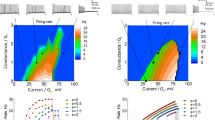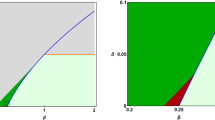Abstract
Spiking neural networks are widely applied to simulate cortical dynamics in the brain and are regarded as the next generation of machine learning. The classical Hodgkin–Huxley (HH) neuron is the foundation of all spiking neural models. In numerical simulation, however, the stiffness of the nonlinear HH equations during an action potential (a spike) period prohibits the use of large time steps for numerical integration. Outside of this stiff period, the HH equations can be efficiently simulated with a relatively large time step. In this work, we present an efficient and accurate offline–online combined method that stops evolving the HH equations during an action potential period, uses a pre-computed (offline) high-resolution data set to determine the voltage value during the spike, and restarts the time evolution of the HH equations after the stiff period using reset values interpolated from the offline data set. Our method allows for time steps an order of magnitude larger than those used in the standard Runge–Kutta (RK) method, while accurately capturing dynamical properties of HH neurons. In addition, this offline–online method robustly achieves a maximum of a tenfold decrease in computation time as compared to RK methods, a result that is independent of network size.
















Similar content being viewed by others
References
Aihara, K.: Chaotic oscillations and bifurcations in squid giant axons. In: Chaos, pp. 257–269 (1986)
Beierlein, M., Gibson, J.R., Connors, B.W.: A network of electrically coupled interneurons drives synchronized inhibition in neocortex. Nat. Neurosci. 3(9), 904–910 (2000)
Börgers, C., Nectow, A.R.: Exponential time differencing for Hodgkin–Huxley-like ODEs. SIAM J. Sci. Comput. 35(3), B623–B643 (2013)
Connors, B.W., Long, M.A.: Electrical synapses in the mammalian brain. Annu. Rev. Neurosci. 27, 393–418 (2004)
Cox, S.M., Matthews, P.C.: Exponential time differencing for stiff systems. J. Comput. Phys. 176(2), 430–455 (2002)
Crodelle, J., Zhou, D., Kovacic, G., Cai, D.: A role for electrotonic coupling between cortical pyramidal cells. Front. Comput. Neurosci. 13, 33 (2019)
Dayan, P., Abbott, L.: Theoretical neuroscience: computational and mathematical modeling of neural systems. J. Cogn. Neurosci. 15(1), 154–155 (2003)
Dayan, P., Abbott, L.F.: Theoretical Neuroscience, vol. 806. MIT Press, Cambridge (2001)
Ding, L., Hou, C.: Stabilizing control of hopf bifurcation in the Hodgkin–Huxley model via washout filter with linear control term. Nonlinear Dyn. 60(1–2), 131–139 (2010)
Galarreta, M., Hestrin, S.: A network of fast-spiking cells in the neocortex connected by electrical synapses. Nature 402(6757), 72–75 (1999)
Gerstner, W., Kistler, W.M.: Spiking Neuron Models: Single Neurons, Populations, Plasticity. Cambridge University Press, Cambridge (2002)
Gu, H., Pan, B.: A four-dimensional neuronal model to describe the complex nonlinear dynamics observed in the firing patterns of a sciatic nerve chronic constriction injury model. Nonlinear Dyn. 81(4), 2107–2126 (2015)
Guckenheimer, J., Oliva, R.A.: Chaos in the Hodgkin–Huxley model. SIAM J. Appl. Dyn. Syst. 1(1), 105–114 (2002)
Hansel, D., Mato, G., Meunier, C., Neltner, L.: On numerical simulations of integrate-and-fire neural networks. Neural Comput. 10(2), 467–483 (1998)
Hansel, D., Sompolinsky, H.: Chaos and synchrony in a model of a hypercolumn in visual cortex. J. Comput. Neurosci. 3(1), 7–34 (1996)
Hassard, B.: Bifurcation of periodic solutions of the Hodgkin–Huxley model for the squid giant axon. J. Theor. Biol. 71(3), 401–420 (1978)
Hertz, J., Prügel-Bennett, A.: Learning short synfire chains by self-organization. Netw. Comput. Neural Syst. 7(2), 357–363 (1996)
Hodgkin, A.L., Huxley, A.F.: A quantitative description of membrane current and its application to conduction and excitation in nerve. J. Physiol. 117(4), 500 (1952)
Ikegaya, Y., Sasaki, T., Ishikawa, D., Honma, N., Tao, K., Takahashi, N., Minamisawa, G., Ujita, S., Matsuki, N.: Interpyramid spike transmission stabilizes the sparseness of recurrent network activity. Cerebral Cortex 23(2), 293–304 (2012)
Ito, S., Hansen, M.E., Heiland, R., Lumsdaine, A., Litke, A.M., Beggs, J.M.: Extending transfer entropy improves identification of effective connectivity in a spiking cortical network model. PLoS ONE 6(11), e27431 (2011)
Koch, C., Segev, I.: Methods in Neuronal Modeling: From Ions to Networks. MIT Press, Cambridge (1998)
Kopell, N., Ermentrout, B.: Chemical and electrical synapses perform complementary roles in the synchronization of interneuronal networks. Proc. Natl. Acad. Sci. 101(43), 15482–15487 (2004)
Mainen, Z.F., Sejnowski, T.J.: Influence of dendritic structure on firing pattern in model neocortical neurons. Nature 382(6589), 363 (1996)
Mattia, M., Del Giudice, P.: Efficient event-driven simulation of large networks of spiking neurons and dynamical synapses. Neural Comput. 12(10), 2305–2329 (2000)
McLaughlin, D., Shapley, R., Shelley, M., Wielaard, D.J.: A neuronal network model of macaque primary visual cortex (v1): orientation selectivity and dynamics in the input layer 4c\(\alpha \). Proc. Natl. Acad. Sci. 97(14), 8087–8092 (2000)
Monteforte, M., Wolf, F.: Dynamic flux tubes form reservoirs of stability in neuronal circuits. Phys. Rev. X 2(4), 041007 (2012)
Nie, Q., Wan, F.Y., Zhang, Y.T., Liu, X.F.: Compact integration factor methods in high spatial dimensions. J. Comput. Phys. 227(10), 5238–5255 (2008)
Oseledec, V.I.: A multiplicative ergodic theorem. Lyapunov characteristic numbers for dynamical systems. Trans. Moscow Math. Soc. 19(2), 197–231 (1968)
Ott, E.: Chaos in Dynamical Systems. Cambridge University Press, Cambridge (2002)
Parker, T.S., Chua, L.: Practical Numerical Algorithms for Chaotic Systems. Springer, Berlin (2012)
Perkel, D.H., Gerstein, G.L., Moore, G.P.: Neuronal spike trains and stochastic point processes: II. Simultaneous spike trains. Biophys. J. 7(4), 419–440 (1967)
Pospischil, M., Toledo-Rodriguez, M., Monier, C., Piwkowska, Z., Bal, T., Frégnac, Y., Markram, H., Destexhe, A.: Minimal Hodgkin–Huxley type models for different classes of cortical and thalamic neurons. Biol. Cybern. 99(4), 427–441 (2008)
Quinn, C.J., Coleman, T.P., Kiyavash, N., Hatsopoulos, N.G.: Estimating the directed information to infer causal relationships in ensemble neural spike train recordings. J. Comput. Neurosci. 30(1), 17–44 (2011)
Rangan, A.V., Cai, D.: Fast numerical methods for simulating large-scale integrate-and-fire neuronal networks. J. Comput. Neurosci. 22(1), 81–100 (2007)
Revel, J., Karnovsky, M.: Hexagonal array of subunits in intercellular junctions of the mouse heart and liver. J. Cell Biol. 33(3), C7 (1967)
Rinzel, J., Ermentrout, G.B.: Analysis of neural excitability and oscillations. Methods Neuronal Model. 2, 251–292 (1998)
Shelley, M.J., Tao, L.: Efficient and accurate time-stepping schemes for integrate-and-fire neuronal networks. J. Comput. Neurosci. 11(2), 111–119 (2001)
Shinomoto, S., Kim, H., Shimokawa, T., Matsuno, N., Funahashi, S., Shima, K., Fujita, I., Tamura, H., Doi, T., Kawano, K., et al.: Relating neuronal firing patterns to functional differentiation of cerebral cortex. PLoS Comput. Biol. 5(7), e1000433 (2009)
Shlens, J., Field, G.D., Gauthier, J.L., Grivich, M.I., Petrusca, D., Sher, A., Litke, A.M., Chichilnisky, E.: The structure of multi-neuron firing patterns in primate retina. J. Neurosci. 26(32), 8254–8266 (2006)
Somers, D.C., Nelson, S.B., Sur, M.: An emergent model of orientation selectivity in cat visual cortical simple cells. J. Neurosci. 15(8), 5448–5465 (1995)
Song, S., Sjöström, P.J., Reigl, M., Nelson, S., Chklovskii, D.B.: Highly nonrandom features of synaptic connectivity in local cortical circuits. PLoS Biol. 3(3), e68 (2005)
Sun, Y., Zhou, D., Rangan, A.V., Cai, D.: Library-based numerical reduction of the Hodgkin–Huxley neuron for network simulation. J. Comput. Neurosci. 27(3), 369–390 (2009)
Sussillo, D., Abbott, L.F.: Generating coherent patterns of activity from chaotic neural networks. Neuron 63(4), 544–557 (2009)
Thompson, J.M.T., Stewart, H.B.: Nonlinear Dynamics and Chaos. Wiley, New York (2002)
Tian, Z.Q.K., Zhou, D.: Exponential time differencing algorithm for pulse-coupled Hodgkin–Huxley neuronal networks. arXiv preprint arXiv:1910.08724 (2019)
Wang, Y., Barakat, A., Zhou, H.: Electrotonic coupling between pyramidal neurons in the neocortex. PLoS ONE 5(4), e10253 (2010)
Wolf, A., Swift, J.B., Swinney, H.L., Vastano, J.A.: Determining Lyapunov exponents from a time series. Phys. D: Nonlinear Phenom. 16(3), 285–317 (1985)
Xu, Z.Q.J., Bi, G., Zhou, D., Cai, D.: A dynamical state underlying the second order maximum entropy principle in neuronal networks. Commun. Math. Sci. 15(3), 665–692 (2017)
Zhou, D., Rangan, A.V., Sun, Y., Cai, D.: Network-induced chaos in integrate-and-fire neuronal ensembles. Phys. Rev. E 80(3), 031918 (2009)
Zhou, D., Sun, Y., Rangan, A.V., Cai, D.: Spectrum of Lyapunov exponents of non-smooth dynamical systems of integrate-and-fire type. J. Comput. Neurosci. 28(2), 229–245 (2010)
Zhou, D., Xiao, Y., Zhang, Y., Xu, Z., Cai, D.: Granger causality network reconstruction of conductance-based integrate-and-fire neuronal systems. PLoS ONE 9(2), e87636 (2014)
Acknowledgements
This work was supported by National Key R&D Program of China (2019YFA0709503), NSFC-11671259, NSFC-11722107, SJTU-UM Collaborative Research Program, and the Student Innovation Center at Shanghai Jiao Tong University (D.Z.); the NSF Mathematical Sciences PostDoctoral Research Fellowship (MSPRF) DMS-1703761 (J.C.). We dedicate this paper to our late professor David Cai.
Author information
Authors and Affiliations
Corresponding author
Ethics declarations
Conflict of interest
The authors declare that they have no conflict of interest.
Additional information
Publisher's Note
Springer Nature remains neutral with regard to jurisdictional claims in published maps and institutional affiliations.
Rights and permissions
About this article
Cite this article
Tian, Zq.K., Crodelle, J. & Zhou, D. A Combined Offline–Online Algorithm for Hodgkin–Huxley Neural Networks. J Sci Comput 84, 10 (2020). https://doi.org/10.1007/s10915-020-01261-6
Received:
Revised:
Accepted:
Published:
DOI: https://doi.org/10.1007/s10915-020-01261-6




